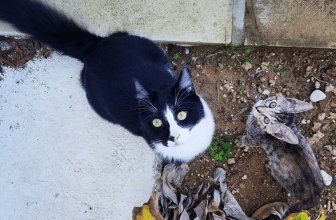Spaying is a term used for the procedure of sterilizing a female cat and has become very common over the years because it improves the health of your pet and increases its lifespan, and also is the safest and most humane method to control stray cat populations.
When you decide to adopt a female kitten from a shelter, from a friend, or get it from a pet store or a breeder they will know if the kitty has been done, so you only have to ask them to find out. But taking in a friendly stray female cat from your neighborhood, or ‘be chosen’ by a cat in an unexpected location like most of us do, telling if she has been spayed gets more difficult as the surgery can be performed from a young age of three months old or when the kitten weighs a minimum of three pounds.
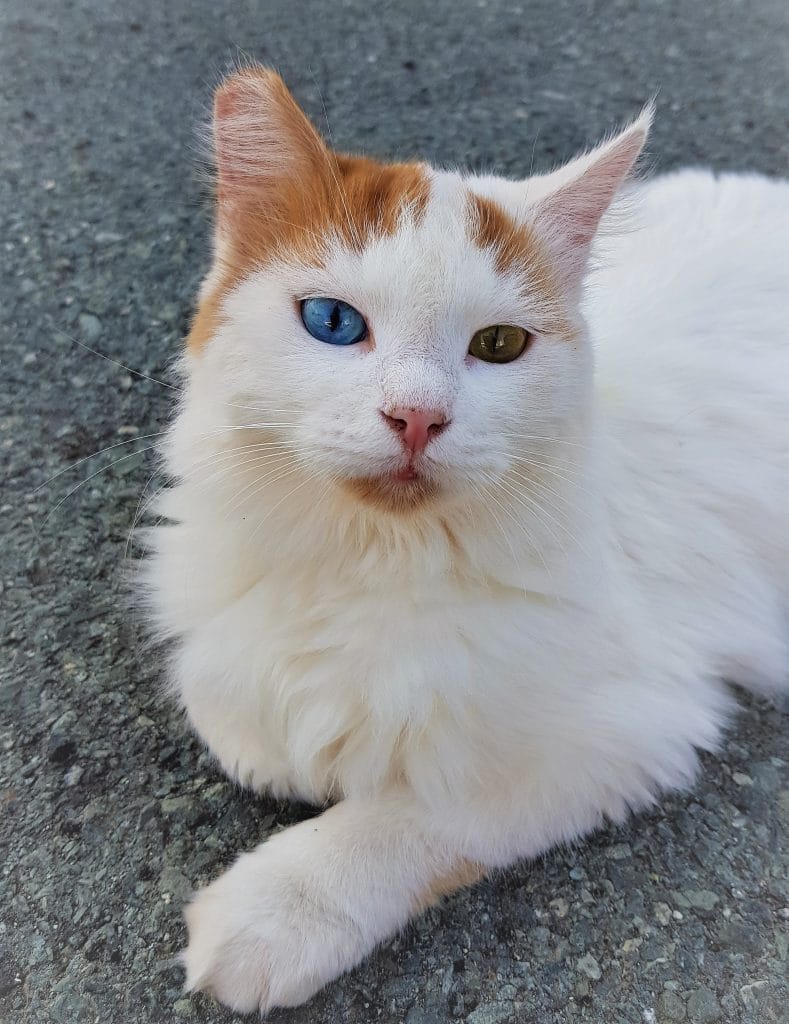
It is important to know if your feline friend has been spayed especially when getting an older female cat so you don’t have to put the kitty through the same procedure again only to find out it has already been fixed. The ovariohysterectomy (spaying) of a female cat is a more complicated surgery than neutering a male cat, as the vet removes the cat’s ovaries and uterus.
In this article, there are four signs that can help you determine by yourself if a cat has been spayed, but if these signs are unclear it is better to take the feline to the vet and let them confirm if it has indeed been altered or not, and if not, why is best to consider spaying your kitty. Read on to find out!
4 ways of telling if a cat has been spayed:
1. An ear-tipping
If your new furbaby is missing the tip of one of its ears, usually the left one but not necessarily, this is the universally accepted sign of marking a cat as spayed or neutered. It is done to all outdoor stray and feral cat communities, mainly through Trap-Neuter-Return programs (TNR) to keep the ownerless pets under control. This can be the easiest way to tell if a kitty has been neutered, but, in some cases, cats that have been pre-owned and then abandoned can already be fixed and not have a tipped ear as the previous owner chose not to alter their image by removing a part of their ear when the sterilizing procedure took place.
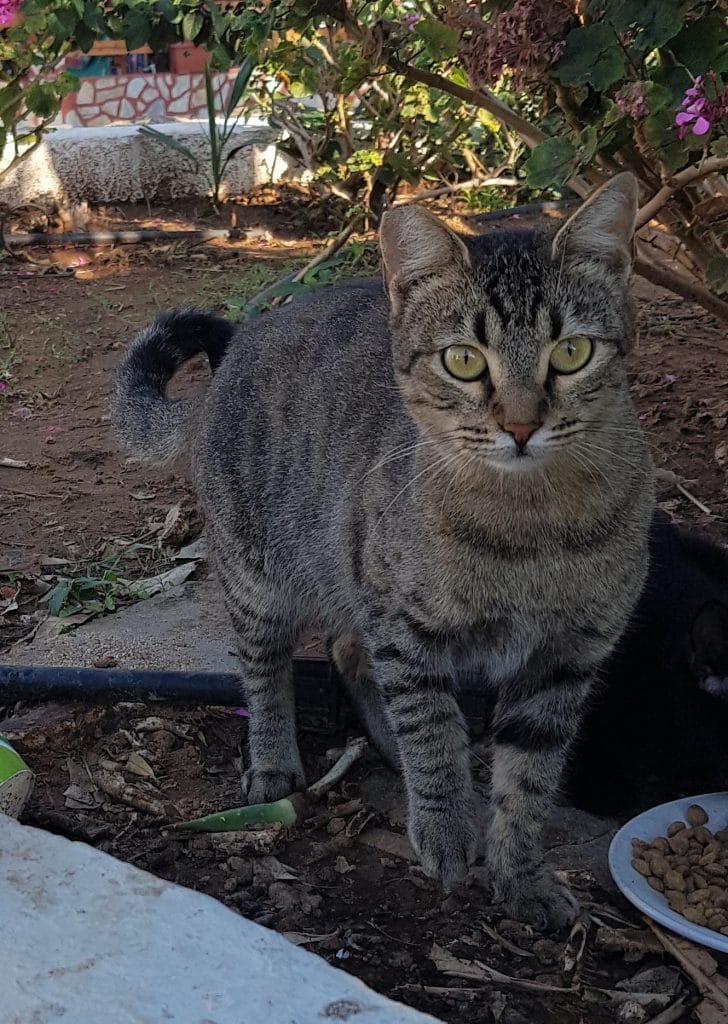
2. A post-operation scar
Looking for a spaying scar helps more if the procedure was carried out recently and the cat would still display shorter hair on the abdomen due to the shaving clean of the fur on the kitties belly done by the vet in preparation for the surgery, which would make it easier for you to search for a scar. Over time, scars start to fade or heal over and will be harder to find especially when the fur grows back. Normally you would find the operation mark straight on the center of the cat’s abdomen if you look lengthwise through the kitty’s fur until you see the skin, or, if the kitten was fixed at a very young age and the vet used the flank approach for the surgery, the scar will appear on the left side of the body between the hip and the rib cage.
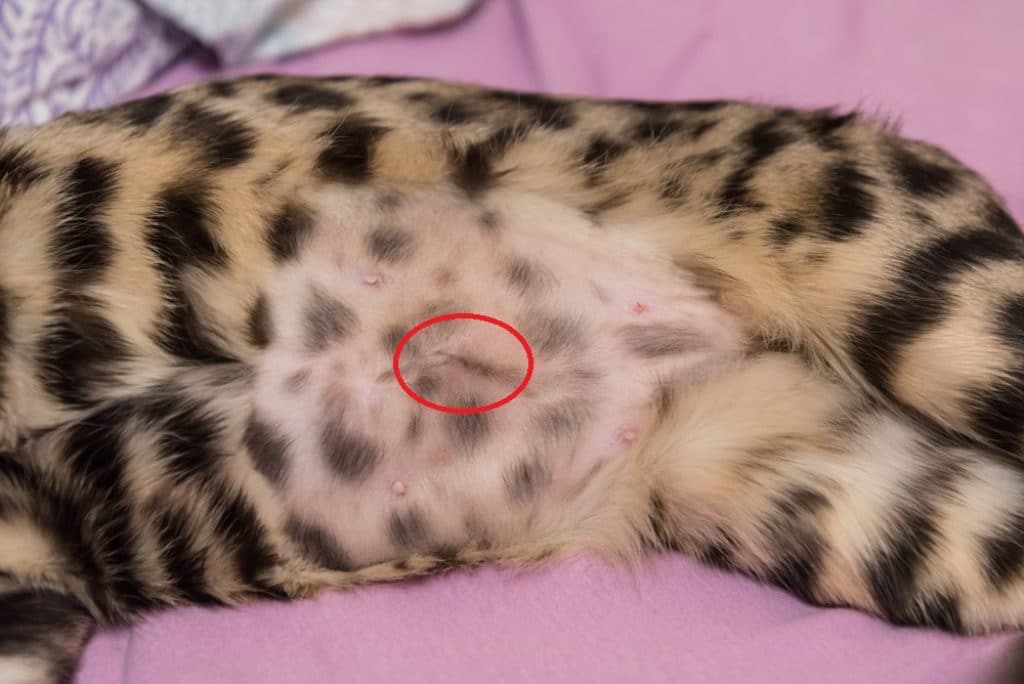
Scars can differ in size and how they look depending on the type of sterilization the vet performed, and the tools that have been used to do it, but I will tell you more about that later.
3. Tattoo markings
When a cat is spayed, instead of clipping her ear, a vet might give her a tattoo as a sign that she has been fixed. Normally this kind of tattoo is a green line and you can find it by carefully checking through your cat’s fur on the abdomen close to the incision scar, or on the cat’s ear.
An M tattoo marking inside the ear means that the cat has been microchipped. By taking the cat to the vet for a microchip scan, even if the previous owner has abandoned the cat or doesn’t want it anymore, the info from the microchip ID, considering it is up to date, can inform the vet if the cat has been already sterilized.
4. Heat cycle
A very revealing way to finding out if a female cat is spayed or not is to wait for it to get in ‘heat’, but also it is not a safe or pleasant way. Unspayed cats, also known as queens, often go into heightened sexual activity periods scientifically known as ‘estrus’ periods that can last as long as three weeks and are more common from spring to autumn months, although indoor cats can get it any time. A queen can get into estrus as early as four months old, but usually happens between 6 and 9 months of age. In the heat period, your cat is overly affectionate, rolls around playfully, rubs against you and other objects often, and lets out yowling meows. In the presence of a male prospect, she will get into a crouching position with her rear elevated, the tail raised and set to the side of her body and her head lowered to the ground, exposing and presenting her genitals to the male.

The queen will want to spend more time outdoors, scratching and making noises at the door, and if she escapes and it’s not spayed she will become pregnant. Other signs of heat can be small amounts of clear and watery vaginal discharge, or sometimes stained with red, and the worst sign of them all is the urine marking. Urine marking or spraying is a very common method for female cats to let males know they are in heat. The urine contains pheromones and hormones that act as signals to attract unneutered male cats, and for humans smells very bad and strong. A sterilized cat will not go into heat anymore.
The vet can make it all clear!
When all other physical signs of the surgery are hard to tell by yourself, the safest way to find out for sure if your cat is spayed is to take the cat to a veterinarian. With medical expertise, they will recognize any physical signs of sterilization better than you would, and if still unclear they can run additional blood tests to find out for sure. The most qualitative blood test is the AMH test that can distinguish between spayed cats and queens by analyzing a specific hormone called the Anti-Müllerian Hormone that can be found only in unspayed cats. Or, the vet can perform an ultrasound scan to check if the uterus and ovaries of the cat have been removed or still intact.
What does a spaying scar look like?
A healing cat spaying scar appears clean, the edges of the incision should be touching each other and it will look more reddish in color for the first few days and inflamed around the altered tissue. Some incisions might present external sutures but most of the slits are closed from the inside. When it’s healed a spaying scar from a traditional spaying procedure will look like a slightly pink vertical clean line on the cat’s abdomen, about 2-3 inches long that feels bumpier to the touch than the rest of the cat’s skin. A laser spay surgery should leave behind a similar-looking mark, but with less scar tissue visible because of the cauterization of the slit by the laser, making this scar harder to find. The third method of spaying, the laparoscopic spay, uses a small camera to see inside the cat’s abdomen and will leave you looking for one to three small incision scars across the abdomen, about 0.19 inches (0.48 cm). These scars are almost impossible to find with time.
Is spaying a cat important?
Yes. Spaying a cat is important for the overall health of the cat. It helps in preventing uterine infections and breast tumors (mammary gland cancer) and also keeps your cat from going into ‘heat’, stopping it from trying to get outside and getting lost, cease the yowling and spraying to attract male cats, and the most important reasons, your cat will live longer and will not give birth to an unwanted litter of kittens. Sterilizing cats is also very important for the stray cat communities keeping at bay the feral cat populations and minimizing the numbers of the “kitten season”.
Spaying Dot
We spayed Dot when she was around 6-7 months old even if at the time she was not going out of the house, and her brother Dobby was already neutered. She started getting in heat around that age, making loud meows demanding affection and attention. Also, she started lifting her butt up towards Dobby when playing or even around us. We decided to do it at that time because we knew we will move, and the furbabies will be able to go out again, and she should enjoy the outdoor without having to deal with a litter of kittens. Her operation was a success and her ear was not clipped as she is not a stray kitten anymore.
This is her napping at home just after we picked her up from the vet post her spaying surgery. The scar is in the healing process and she has internal and external stitches. Also, her belly will be a bit swollen for a few days. I will post more pictures of her healing process.
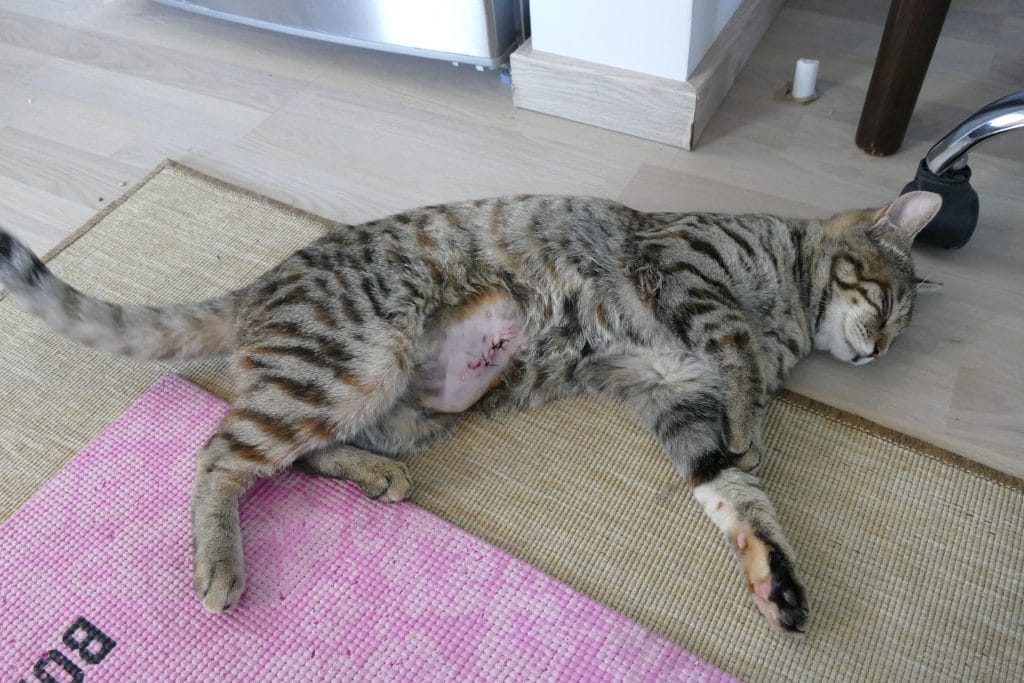
Here is Dot just a few days after the spaying operation when she started healing internally and her belly was not so swollen anymore post-surgery.
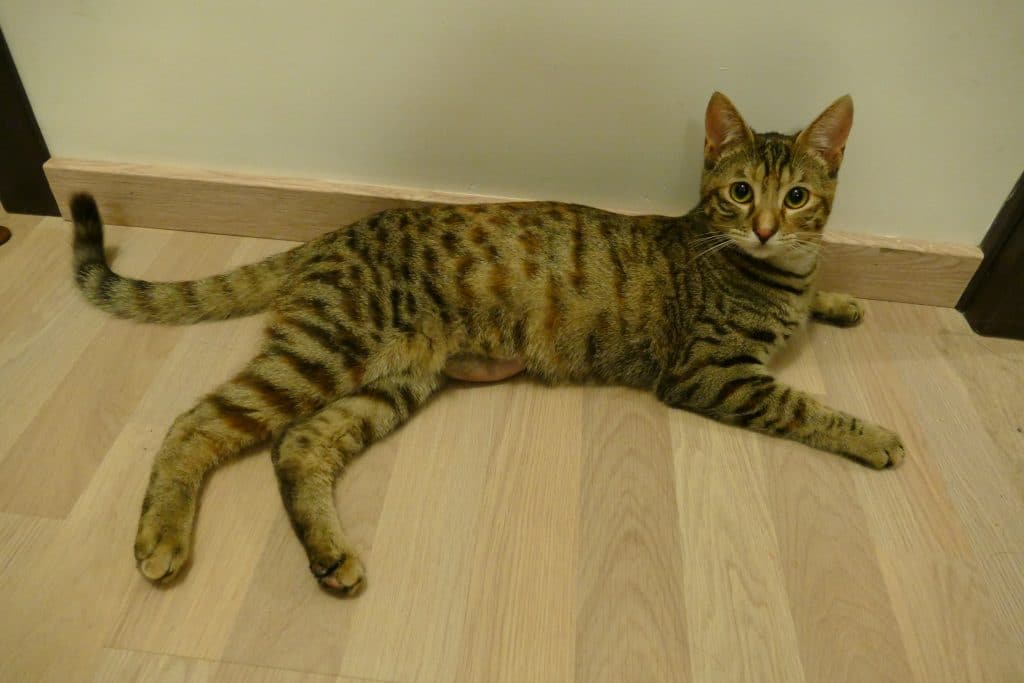
One month after the surgery, the stitches are out and the abdominal hair is starting to slowly grow back. The scar is nicely healed and small, almost not visible anymore because of her fur patterns and as soon as the hair fully grows back I am sure it will be hard to tell if she is spayed. That’s why it’s so important to take a female cat to the vet to figure out if she is already spayed if there are no visible spaying signs!
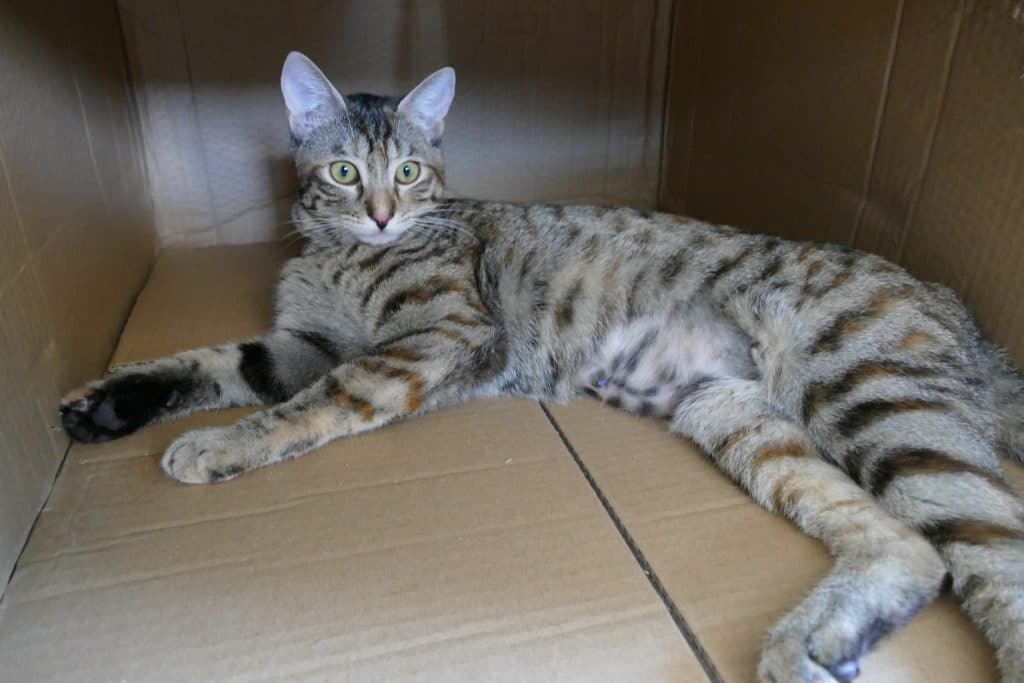

Forget about the spaying ‘myths’ and misconceptions
Sterilization will not make your cat gain weight, the lack of exercise for not wandering around looking trying to mate will, or a passible overfeeding, but if you are scared of this you can always change your cat’s diet to food specially made for sterilized cats.
Spaying will not change all the ‘bad behavior’ that your cat may have acquired over time. It will make the cat more affectionate and stop it from being aggressive, she will not stink your house by spraying everywhere or wake you up scratching at doors to go out and meet her needs, but will not change other odd behavior not related to heat hormones, like scratching mirrors, pooping outside the litter box and so on.
If you have gone this far, here is what you need to remember:
How can you tell if a cat has been spayed?
You can tell if a cat is spayed if she presents one of the following physical signs:
- Ear tipping: a missing ear tip, or ear clipping.
- Post-operation scar: if the cat is still displaying growing hair on her abdomen or you found an incision mark lengthwise at the center of her tummy, about 2-3 inches long.
- Tattoo: she has a spaying green line tattoo on her abdomen or her ear as a spaying mark done by a vet after the surgery.
- Heat cycle: she has started to show ‘heat’ signs like yowling and spraying.
Or you can just simply take your cat to the vet and do an AMH test or an ultrasound scan to confirm for sure that the ovariohysterectomy was performed on the cat.
We would love to hear your opinion about cat spaying in the comments below, and of course, if this article was pawesome enough to offer you information that you did not know befurr.





